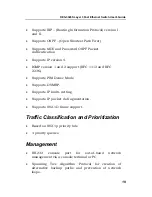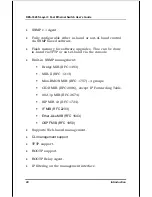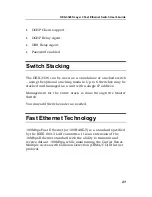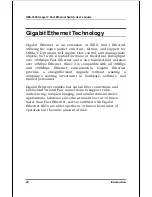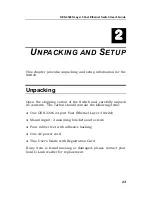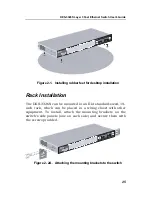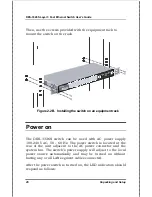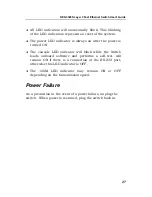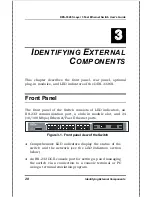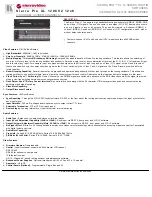
DES-3326S Layer 3 Fast Ethernet Switch User’s Guide
14 Introduction
Ethernet port to connect to a separate device, which in turn,
connects the network to a WAN or the Internet.
The DES-3326S can be thought of as 24 Fast Ethernet Layer 2
switching domains with a wire-speed router between each
domain. It can be deployed in a network between a traditional
router and the intranetwork. The traditional router and its
associated WAN interface would then handle routing between
the intranetwork and the WAN (the Internet, for example) while
the Layer 3 switch would handle routing within the LAN
(between the Fast Ethernet Layer 2 domains). Any installed
Layer 2 switches, and indeed the entire subnetting scheme,
would remain in place.
The DES-3326S can also replace key traditional routers for
data centers and server farms, routing between these locations
and the rest of the network, and providing 24 ports of Layer 2
switching performance combined with wire-speed routing.
Backbone routers can also be replaced with DES-3326S and a
series of DES-3326S could be linked via the optional Gigabit
Ethernet ports. Routers that service WAN connections would
remain in place, but would now be removed from the backbone
and connected to the DES-3326S via an Ethernet/Fast
Ethernet port. The backbone itself could be migrated to
Gigabit Ethernet, or faster technologies as they become
available.
The DES-3326S accomplishes two objectives. First as a tool to
provide high-performance access to enterprise data servers and
infrastructure, and second, to enhance the performance of
network equipment already installed. Many network segments
display poor performance, but the Ethernet wire is only
carrying a fraction of its total traffic capacity. The problem is
not necessarily the network, but the ability of the connected
devices utilize the full capacity of the network. The DES-
3326S can eliminate network bottlenecks to high-traffic areas,



















